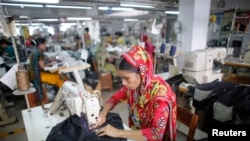Human Rights Watch has slammed Bangladesh’s garment industry for using anti-union tactics to stifle efforts by workers to form unions.
A new report calls on the government and Western retailers to do more to protect workers rights in the country’s flourishing garment sector, which came under the international spotlight for lack of safety following a disastrous collapse of a factory two years ago.
Threats, verbal assault, physical abuse, unpaid wages and dismissal are some tactics used by some factory owners to push back against unions in Bangladesh’s garment industry, according to the report titled “Whoever Raises Their Heads Suffers the Most” which was released on Wednesday in Dhaka by Deputy Director of Human Rights Watch Asia, Phil Robertson.
The report says a larger number of unions have been registered following labor law reform to boost workers rights in the wake of the deadly building collapse that killed more than 1100 garment workers in the Rana Plaza building in Dhaka two years ago.
But Robertson cites many instances of retaliation against workers trying to form unions.
“These crackdowns involve not only verbal harassment, and intimidation, but in some cases significant and serious instances of abuse," he said. "We have stories of a union president being beaten in the factory… We have thugs being hired by factory owners to follow people, we have cases of sexual harassment where supervisors basically attack workers verbally.”
The HRW report also cites forced overtime, denial of paid maternity leave, and failure to pay wages and bonuses on time, or in full as some of the intimidating tactics faced by those organizing or joining unions.
It says workers also face poor working conditions.
The report is based on interviews with 160 workers from 44 factories making garments for retailers in North America, Europe and Australia.
It underlines the need for unions in the industry, pointing out that a union in the Rana Plaza factory would have helped reluctant employees fend off demands by managers to continue work in the building which had developed major cracks.
The Rana Plaza collapse raised an international outcry and prompted initiatives for a safety overhaul in Bangladesh’s garment factories.
But Robertson says if Bangladesh wants to avoid a similar disaster, it must effectively implement labor laws.
“That is going to have to involve workers voices because workers are on the frontline of workers safety issues," Robertson said. "These are the people who are being injured by unsafe factories and factory fires or factory collapses. To leave them out of the equation, to try to silence them when they assert their rights betrays the spirit of accountability.”
The rights body says factory owners have rejected allegations of intimidation against labor leaders.
It says an official of the Bangladesh Garment Manufacturers and Exporters Association told the rights body that, “We have a bitter experience about unions. They believe they don’t need to work and they will get paid.”
Garment industry representatives say that in the last two years there has been progress in addressing problems besetting the industry, including that of workplace safety and worker representation.
Rubana Huq is Managing Director at the Dhaka-based Mohammadi group which supplies clothing to several Western retailers.
“You must also understand that a sector cannot change overnight," Huq said. "It is a work in progress and that the industry is allowing more and more unions to be formed, that is indication enough that the industry is changing and is more accepting of unions.”
Human Rights Watch however points out that fewer than 10 percent of garment factories have unions, despite the new labor laws.
The report also says that much remains to be done to support the victims of the collapse of Rana Plaza and a previous fire that killed 117 workers at another factory (Tazreen) in November, 2012.
The $24 billion garment sector is the backbone of the country’s export industry and employs about four million workers - mostly women.







